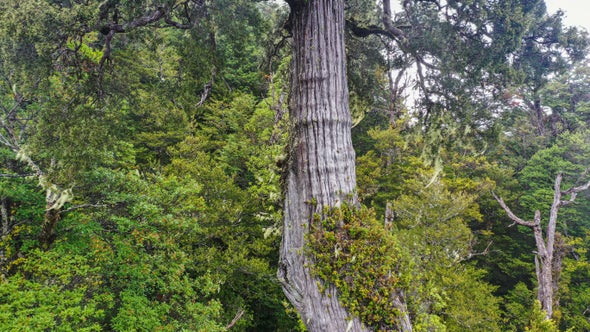A Patagonian cypress known as Lañilawal or Alerce Milenario may be the oldest tree on Earth. One researcher estimates it sprouted more than 5,000 years ago, well before the Great Pyramid of Giza was even built.
The age estimate hasn’t been verified yet, and other scientists are skeptical it will be. Regardless of this designation, its life in Chile’s Alerce Costero National Park could end without greater protection, says Jonathan Barichivich, a research professor at the French National Center for Scientific Research (CNRS) in France. Barichivich’s grandfather, Aníbal Henríquez, who would become the first park warden for Alerce Costero, discovered Lañilawal in the 1970s. “Even though it’s a protected area, [the tree] is not necessarily protected,” says Barichivich, who is Indigenous Chilean.
Lañilawal—named for the word describing its location in the Indigenous Mapudungun language —is under stress from tourism and a warming, drying climate pattern, Barichivich says. (Alerce means “larch” in Spanish.)
Giants such as Lañilawal, which towers 28 meters tall and has a trunk 4.2 meters wide, are the endurance athletes of the natural world, outlasting their peers and adapting to myriad threats, Barichivich says. Saving these trees is important for understanding how they survive so long, he adds.
Officially, the oldest tree on Earth is Methuselah, a bristlecone pine of the species Pinus longaeva in the Inyo National Forest of California that is at least 4,789 years old, according to the U.S. Department of Agriculture. The Lañilawal cypress (Fitzroya cupressoides) could be older. In 2022 Barichivich and his colleagues told reporters that they had taken a core through 40 percent of Lañilawal’s diameter that had 2,400 growth rings. Extrapolating from that finding and factoring in historical climate data and the ages of other Alerce trees, Barichivich calculated an 80 percent chance that the tree is more than 5,000 years old and found that it is perhaps as ancient as 5,484 years.
The researchers have not yet published their results in a peer-reviewed journal, and many scientists are skeptical of the extreme age. It’s not easy to date the oldest trees, says Chuck Cannon, director of the Center for Tree Science at the Morton Arboretum in Illinois. Trees can generate more than one ring a year or go years without a ring, and those counting errors can add up over centuries, Cannon says. Old wood in the centers of trees may rot away, erasing years of history. To measure a tree, researchers must be able to get a full core to the trunk’s center.
“Only a tiny subset of elderflora [old trees] meets that measurement requirement,” says Jared Farmer, a historian at the University of Pennsylvania and author of the book Elderflora: A Modern History of Ancient Trees (Basic Books, 2022). “But I’m not sure numerical champions should matter so much. There are long-lived plants worthy of protection and care nearly everywhere.”
Even an age closer to 2,400 years would put Lañilawal in the top dozen or so ancient trees in the world. These veteran trees share two key features, Barichivich says: One, they grow slowly. Growing too fast can stress a tree and make it harder for the plant to move nutrients from roots to branches. Two, their wood resists decay. As the old wood in a Patagonian cypress dies, Barichivich says, it fills with tannins and other compounds that help prevent decay. (Redwood trees also have strong, tannin-rich wood and can live for more than 2,000 years.)
Trees are remarkably adaptable, Cannon says. One way they adapt is through epigenetics. As trees grow, they can accumulate changes in gene expression that can be passed along to their offspring. The trees’ DNA stays the same, but changes occur to the regulatory molecules around the DNA that determine if a certain gene gets translated into a protein.
This is one way that ancient trees can add to the genetic diversity of a forest, Cannon says. Another is that these old trees have seen it all: a forest may not have experienced a severe drought for centuries, but a 600-year-old tree that established itself during the last dry spell may be particularly adapted to those conditions—and so might any of its offspring.
Drought is a key threat to Lañilawal now, Barichivich says. Overall, the climate in southern Chile is trending warmer and dryer. And a viewing platform that sits just two meters from the tree covers much of its active root system. Barichivich and his colleagues have found that this platform blocks about 50 percent of precipitation from reaching Lañilawal’s roots. “In the near future,” he says, “we might need to irrigate the tree.”
Barichivich has called on the Chilean government to seek UNESCO World Heritage Site status for Lañilawal. Park authorities have put limits on visitation near the tree to help protect its root system, but the platform should be moved farther away, and a protective net should be erected to stymy trespassers, Barichivich says. “It’s our responsibility of that part of the world now to protect this treasure of the natural world, and Chile as a country should really do that,” he says, “because it’s part of our identity.”


